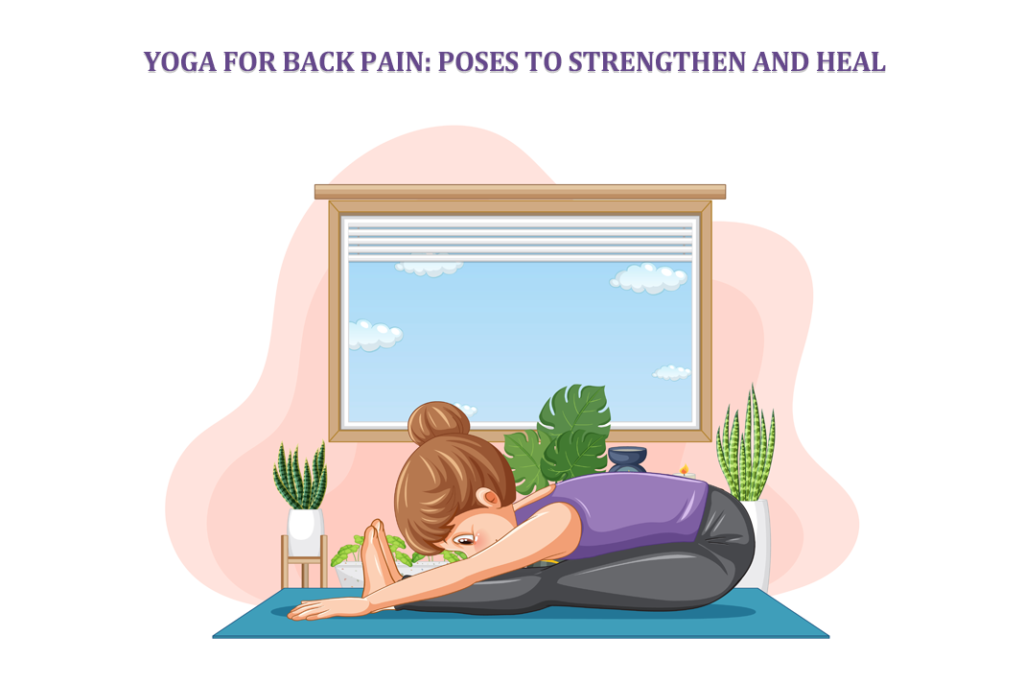Are you tired of chronic back pain affecting your daily life? Whether it’s due to poor posture, muscle strain, or a chronic condition, back pain can be debilitating. But there’s hope. Yoga, a practice with a rich history and known for its holistic benefits, can provide relief and strengthen your back. With targeted poses, yoga can enhance flexibility, build muscle strength, and correct spinal alignment. This guide delves into several yoga postures specifically designed to alleviate back pain, offering relief and promoting overall health.
Benefits of Yoga for Back Pain
Yoga is more than just stretching; it’s a comprehensive practice that integrates physical postures, breathwork, and mindfulness. For those grappling with back pain, yoga offers a holistic approach with numerous benefits. It enhances spinal flexibility and reduces stiffness in surrounding muscles. It strengthens core muscles that support the lower back, improving posture and balance. And it provides a sense of relaxation, reducing the stress that can exacerbate pain. Regular yoga practice at home can help you maintain a healthy, robust, and resilient body.
1. Cat-Cow Stretch (Marjaryasana-Bitilasana)
A soothing and relaxing way to loosen up those back muscles and get your spine warmed up is the Cat-Cow stretch. Start on all fours, with your wrists directly beneath your shoulders and knees under your hips. With an inhalation, get into Cow Pose by arching your back and bringing your head and tailbone up toward the ceiling. Cat Pose is an exhalation-inducing yoga posture in which the practitioner draws their belly button toward their spine and tucks their chin into their chest. Move gently and rhythmically through this sequence for multiple breaths. This position is excellent for releasing back, shoulders, and neck stress while making the spine more flexible.
2. Downward-Facing Dog (Adho Mukha Svanasana)
Downward-Facing Dog stretches and strengthens the whole body, especially the shoulders and back, as a basic yoga posture. Begin on all fours, then straighten your legs to create an inverted V shape as you raise your hips toward the ceiling. With your fingers extended wide, sink your palms deeply into the mat. Maintain a neutral head position and look down at your feet. As you hold the position for a few breaths, you should feel a stretch in your legs and spine. A more elongated spine, less strain on the lower back, and better posture benefit from the downward-facing dog stance.
3. Child’s Pose (Balasana)
Child’s Pose is a soothing position that stretches the hamstrings, hips, and thighs. Start on all fours, then sit back on your heels. As you fold forward, extend your arms either side of your body or in front of you. Let your forehead rest on the mat as you breathe deeply and relax your entire body. This pose is a wonderful way to unwind when you’re feeling tight in your lower back. Use Child’s Pose to relax your body and mind, or as a transition between more challenging poses.
4. Cobra Pose (Bhujangasana)
The backbend, known as Cobra Pose, can help increase spinal flexibility and strength when practiced regularly. In this yoga position, you should lie on your stomach, legs spread wide, and feet flat on the floor. Keep your elbows tight to your sides and your hands beneath your shoulders. With a slight bend in your elbows and your shoulders back and away from your ears, press your hands into the ground to elevate your chest off the ground while you inhale. Gently bring yourself back down from the pose after holding it for a few breaths. To ease lower back pain, open the chest, and strengthen the upper back, try Cobra Pose.
5. Bridge Pose (Setu Bandhasana)
As you extend your chest and hip flexors, you strengthen your back, glutes, and hamstrings in the muscular Bridge Pose. Place your hands flat on the floor, hip-width apart, and bend your knees. Lie down on your back. Keep your hands facing down and your arms at your sides. Breathe deeply as you push through your heels and shoulders to raise your hips toward the ceiling. For a few deep breaths, clasp your hands beneath your body if it helps you to relax. The benefits of Bridge Pose include a strengthened core, better posture, and less strain on the lower back.
6. Pigeon Pose (Eka Pada Rajakapotasana)
Deep hip flexor and lower back muscles stretch well in Pigeon Pose. Beginning on a tabletop, move your right knee forward until it is behind your right wrist, then bring your right ankle close to your left wrist. Maintaining a square posture with your hips facing forward, straighten your left leg and extend it back. Put your forearms or forehead on top as you lower your right leg over your torso. After a few breaths, switch sides of the body and hold the pose. Stretching out the hips and lower back, increasing flexibility, and relieving sciatica pain are all benefits of the Pigeon Pose.
7. Spinal Twist (Supta Matsyendrasana)
Spinal Twist is an easy yoga posture that opens up the spine and releases muscular tension in the back. Place your hands flat on the floor and bend your knees to straighten your back. Make a T position with your arms spread wide. While keeping your shoulders firmly planted on the ground, slowly lower your knees to the right. Hold the position for a few breaths, and if it feels good, turn your head to the left. Before moving on to the opposite side, come back to the middle. The spinal twist benefits from stretching the spine, increasing blood flow, and relieving hip and lower back strain.
8. Locust Pose (Salabhasana)
Strengthening your back, glutes, and legs is the goal of the locust position. Position yourself on your belly, arms at your sides, palms facing down. Breathe deeply as you stand tall, keeping your chin, shoulders, and hips lifted and your eyes directed forward. Exhale as you bring your back down from the pose after holding it for a few breaths. If you suffer from low back pain, poor posture, or weak muscles along your spine, Locust Pose may be just what you need. It improves stability and strength all across the body.
9. Reclining Hand-to-Big-Toe Pose (Supta Padangusthasana)
Hamstrings, hips, and lower back are all stretched out in the calming Reclining Hand-to-Big-Toe Pose. Relax in a backward position with your legs spread wide. Put your right hand on your big toe and bend your right knee; a strap can be used if needed. Lift your right leg slowly toward the ceiling while keeping your left leg firmly planted on the ground. Let your lower back and hamstrings stretch as you hold the position for a few breaths. Do the opposite and start over. This position is excellent for easing sciatica pain, increasing flexibility, and releasing tension in the lower back.
10. Happy Baby Pose (Ananda Balasana)
The lighthearted stretch, Happy Baby Pose, relieves hip and lower back strain. Position yourself on your back with your knees bent toward your chest. While maintaining your arms behind your knees, firmly grasp the sides of your feet. Pull your heels toward the floor, extending your spine and hips. Stay in the position for a few breaths, swaying slightly. Stretching out the lower back, hips, and groin in Happy Baby Pose is a great way to relax and unwind.
11. Sphinx Pose (Salamba Bhujangasana)
Sphinx Pose is an easy way to open your chest and strengthen your lower back. In this yoga position, you should lie on your stomach, legs spread wide, and feet flat on the floor. Bend over with your arms at your sides and your palms facing outward. While maintaining your lower ribs pressed into the mat, raise your chest and head in one inhalation. Feel the little stretch in your lower back as you hold the pose for a few breaths. Sphinx Pose is a great posture enhancer, back pain reliever, and spinal strengthening exercise.
12. Seated Forward Bend (Paschimottanasana)
The Seated Forward Bend stretches the back, hamstrings, and calves to calm the mind and body. Kneel on the floor and stretch out your legs wide. Exhale as you bend forward from the hips, reaching for your shins or feet, and inhale as you stretch your spine. Maintain a straight back and loose shoulders as you hold the position for a few breaths. Relax your back, increase flexibility, and quiet your mind with the Seated Forward Bend.
13. Legs-Up-the-Wall Pose (Viparita Karani)
If you suffer from lower back pain or want to relax, try Legs-Up-the-Wall Pose. While lying on the floor, lean one side of your body against a wall and raise your legs against the wall in a swinging motion. Get into a standing posture with your legs extended and your hips parallel to the wall. Relax with your arms at your sides and gently shut your eyes while taking deep breaths. Keep your legs and lower back relaxed by holding the position for a few minutes and letting gravity work magic. The calming effects, increased circulation, and less swelling benefit this stance.
14. Supine Bound Angle Pose (Supta Baddha Konasana)
In a calming way, the lower back, inner thighs, and hips can be stretched in the Supine Bound Angle Pose. Place your hands flat on the floor and bend your knees to straighten your back. Make a diamond shape with your legs by bringing the soles of your feet together and letting your knees fall open. With your palms facing up, close your eyes and place your arms at your sides. Find a comfortable position by taking deep breaths. Relaxation, hip opening, and lower back pain are all benefits of this yoga position.
15. Corpse Pose (Savasana)
Rest your body and mind in Corpse Pose, the last relaxation pose in yoga, and let the benefits of the practice sink in. Place your hands on either side of your body, palms facing up, and lay flat on your back. Gently shut your eyes and breathe in a calm, relaxed manner. For a few minutes, hold this position while you relax your body and mind. The benefits of Corpse Pose include better sleep, less stress, and enhanced general health.
Conclusion
Making yoga a regular part of your regimen can significantly improve back pain. These positions may strengthen your back muscles, increase flexibility, and encourage better spinal alignment. In addition to improving your physical health, yoga positively affects your mental and emotional health. Please pay attention to how your body feels as you work up to more challenging poses; take it easy at first. When practiced regularly, using indoor mats with perseverance, yoga can help alleviate back discomfort and promote overall wellness.

